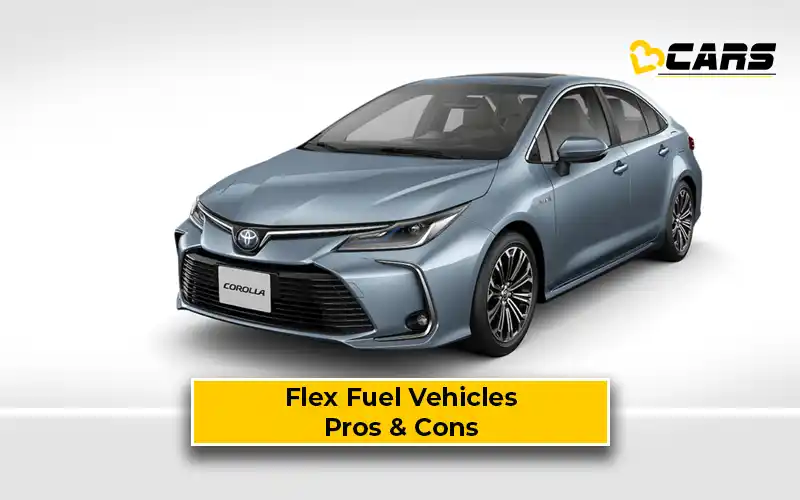Flex Fuel Vehicles - Pros And Cons | V3Cars
As you already know that the international community is pushing for alternative fuels to limit climate change and get a handle on pollution. Among the options the Indian government is considering are flex fuel vehicles, EVs or electric cars and hydrogen fuel-cell vehicles of FCVs. in this article, we’ll briefly understand the workings of flex fuel cars and then discuss the pros and cons of flex fuel vehicles. With this information, you can decide if you should wait for flex fuel vehicles or pick another type of alternative fuel car.

What Is A Flex Fuel Vehicle?
The government recently started adding 10% ethanol in BS6 petrol. While existing petrol cars can run on 10% ethanol, the government intends to increase the portion to 20% by 2025. To run on 20% ethanol mixture in petrol, the carmakers need to make some changes to the petrol engines. Other than that, the flex fuel cars will run just like they do on petrol and they’ll mostly maintain their driving characteristics and efficiency figures.
What Are The Pros Or Advantages Of Flex Fuel Vehicles?
Below are the 8 major benefits of flex-fuel vehicles.
1. Likely To Cost Less Than Petrol
Adding 10% ethanol is already helping the government keep the petrol cost in check despite high currency exchange rates and crude oil prices. Increasing it to 20% is likely to make flex fuel vehicles a solid alternative for buyers currently buying a diesel vehicle. We can expect the E20 flex fuel to cost about the same as diesel, which will help the government ramp up adoption for this new fuel type while discouraging the purchase of diesel cars.
2. Helps Reduce Dependence On Crude Oil & Provides Cushion Against Oil, Currency Fluctuations
The 20% ethanol blend in petrol will help us cut our crude oil imports. Thus, it’ll provide at least some cushion against the high USD-INR exchange rates and volatile crude oil prices.
3. Helps Contain Foreign Cash Outflow
Limiting crude import with the help of flex fuel will also help our economy as it reduces foreign cash outflow. This helps strengthen our economy as it is likely to improve the rupee valuation in the international marketplace.
4. Produces Less Greenhouse Gas In Combustion
While small, even a 20% bio-ethanol blend will help in cutting down some greenhouse gas emissions. After all, every drop of crude saved from burning adds up to saving the environment and delaying the climate catastrophe.
Note: Check your Car EMI with our - Car Loan EMI Calculator
5. Uses Waste Materials For Production
Under the government’s ‘waste-to-wealth’ program, using waste products like straw, sugarcane, bamboo and waste grains makes the raw material abundant and cheap for producing bioethanol sustainable for the long-term.
6. Creates A New Bio-Fuel Production Sector & Employment Opportunities
We know how big the oil sector is. As ethanol challenges the oil sector, in itself, it has the potential to create a big sector and offer plenty of employment opportunities for the Indians.
7. Relatively Easier To Adopt By Modifying Existing Petrol Engines
Flex fuel also uses an internal combustion engine to run. Therefore, scaling up the adoption of flex fuel vehicles is a lot easier than that of hydrogen or electric vehicles. Even modifying existing petrol engines is relatively easy as the core propulsion technology is the same as that of a petrol engine.
8. Uses Existing Storage, Transportation & Distribution Infrastructure
Just like petrol and diesel, flex fuel also remains in liquid form at room temperature. So, storing it, transporting it and distributing it can use the same infrastructure as that for petrol. This will also make adoption easier for car buyers as they don’t need to wait for the infrastructure to catch up.
Note: Check your car’s fuel cost with Fuel Cost Calculator in India
What Are The Cons Or Problems With Flex Fuel Vehicles?
Here are the 3 notable disadvantages of flex-fuel vehicles.
1. Not Suitable For Current Petrol Engines
While the existing petrol engines can handle 10% ethanol blend, the proposed 20% blend will require some modifications to the fueling system and the engine. So, the typical petrol engine is not suitable for running E20 flex fuel.
2. Ethanol Is More Hygroscopic Than Petrol
Ethanol attracts moisture far more easily than petrol. So, using E20 flex fuel and leaving the car unused for long periods of time can result in corrosion of the fuel tank, fuel pipe and other parts of the fuel system.
3. Doesn’t Drastically Lower Ownership Costs
While we’re counting on the flex fuel to cost about the same as diesel does today, it won’t help you save enough cash during the ownership costs. The maintenance costs will also remain similar to that of a petrol car. In this category, electric vehicles hugely outperform all other alternative and traditional fuel vehicles with their drastically lower fuel and maintenance costs.
Also Read - Toyota Launch Corolla Altis Flex-Fuel Hybrid Pilot Project


0 Comments